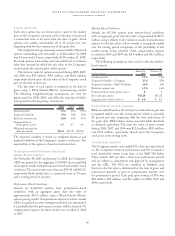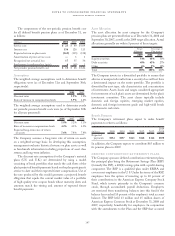American Express 2008 Annual Report Download - page 99
Download and view the complete annual report
Please find page 99 of the 2008 American Express annual report below. You can navigate through the pages in the report by either clicking on the pages listed below, or by using the keyword search tool below to find specific information within the annual report.
notes to consolidated financial statements
american express company
97
note 14
derivatives and hedging
activities
The Company uses derivative financial instruments to
manage exposure to various market risks, such as changes in
benchmark interest rates and foreign exchange rates. These
instruments enable end users to increase, reduce, or alter
exposure to various market risks and, for that reason, are an
integral component of the Company’s market risk and related
asset/liability management strategy and processes. Overall
market risk exposures are monitored and managed by the
Market Risk Committee, guided by Board-approved
policies covering derivative financial instruments, funding,
and investments.
For the Company’s charge card and fixed-rate lending
products, interest rate exposure is managed by using fixed-
rate debt. For the majority of its cardmember loans, which are
linked to a floating rate base and generally reprice each month,
the Company uses floating rate funding. The Company uses
derivative instruments, primarily interest rate swaps, to achieve
a targeted mix of fixed and floating rate funding. The Company
regularly reviews its strategy and may modify it based on
market conditions.
fair value measurements
The fair value of the Company’s derivatives is estimated
by using pricing models that do not contain a high level of
subjectivity as the valuation techniques used do not require
significant judgment and inputs to those models are readily
observable from actively quoted markets. The valuation models
used by the Company are consistently applied and reflect the
contractual terms of the derivatives, including the period of
maturity, and market-based parameters such as interest rates,
foreign exchange rates, equity indices or prices, and volatility.
In certain instances, credit valuation adjustments are
necessary when the market parameters (for example, a
benchmark curve) used to value derivatives is not indicative
of the credit quality of the company or its counterparties. The
Company considers the counterparty credit risk by applying an
observable forecasted default rate to the current exposure.
The Company manages derivative counterparty credit risk
by considering the current exposure, which is the replacement
cost of contracts on the measurement date, as well as estimating
the maximum potential value of the contracts over the next
twelve months, considering such factors as the volatility of the
underlying or reference index. To mitigate derivative credit risk,
counterparties are required to be pre-approved and rated as
investment grade. Counterparty risk exposures are monitored
by the Company’s Institutional Risk Management Committee
(IRMC). The IRMC formally reviews large institutional
exposures to ensure compliance with the Company’s Enterprise-
wide Risk Management Committee guidelines and procedures
and determines the risk mitigation actions, when necessary.
Additionally, the Company may, on occasion, enter into master
netting agreements.
As of December 31, 2008, the credit and nonperformance
risks associated with the Company’s derivative counterparties
were not significant.
The following table summarizes the total fair value, excluding interest accruals, of derivative product assets and liabilities at December 31:
(Millions) 2008(a) 2007
Assets Liabilities Assets Liabilities
Cash flow hedges $ — $125 $ 11 $122
Fair value hedges 1,072 — 114 —
Net investment hedges 535 165 62 2
Derivatives not designated as hedges 136 154 60 46
Total fair value, excluding interest accruals(b) $1,743 $444 $247 $170
(a) SFAS No. 157 was adopted by the Company on January 1, 2008. The fair values of the Company’s derivative instruments are classified within Level 2 of the fair
value hierarchy.
(b) Financial Interpretation No. 39, “Offsetting of Amounts Related to Certain Contracts” (FIN 39), permits the netting of derivative assets and derivative liabilities
when a legally enforceable master netting agreement exists between the Company and its derivative counterparty. At December 31, 2008 and 2007, $39 million and
$8 million, respectively, of derivative assets and liabilities have been offset and represents the impact of legally enforceable master netting agreements that provide
for the net settlement of all contracts in accordance with FIN 39.
























